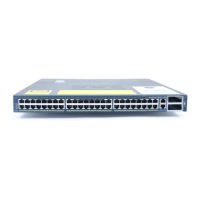56 Cisco LAN Switching Configuration Handbook
4-2: Port Selection
■ When configuring a Layer 2 port or interface, the port must first be selected or iden-
tified.
■ Cisco IOS switches allow a range of interfaces to be defined by using the interface
range EXEC command.
Configuration
1. Select a port:
(global) interface type mod/num
A switch port is called an interface and is identified by its type (fastethernet,
gigabitethernet, and so on), module number mod, and port number num.
2. Select a range of ports:
(global) interface range port-range
OR
(global) define interface-range macro-name port-range
(global) interface range macro macro-name
The Cisco IOS switches allow lists or ranges of interfaces to be given once so that
subsequent commands are applied to each of the interfaces. A port-range is defined
as the interface type (ethernet, fastethernet, gigabitethernet, tengigabitethernet, or
vlan) followed by the module number, a slash (/), and the starting port number. The
end of the range is given by a space, a hyphen, another space, and the ending port
number. If additional ranges are given, the ranges must be separated by a comma.
The basic range format is type slot/first-port - last-port [,type slot/first-port - last-
port ...], where up to five different ranges can be listed. Following the interface
range command, you are placed into interface configuration mode.
If you need to make several configuration changes to a range of interfaces, you can
define a macro that contains a list of interface ranges. Use the define interface-range
command, with a macro-name (arbitrary text name) and a port-range (list of inter-
face ranges as defined earlier). You can save this macro in the switch configuration so
that you can reference it in the future. To invoke the interface range macro, use the
interface range macro command with the macro-name.

